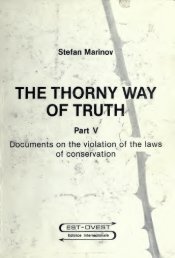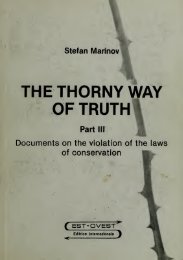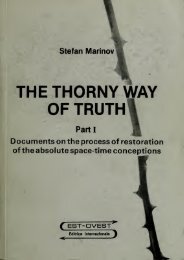The thorny way of truth - Free Energy Community
The thorny way of truth - Free Energy Community
The thorny way of truth - Free Energy Community
- No tags were found...
Create successful ePaper yourself
Turn your PDF publications into a flip-book with our unique Google optimized e-Paper software.
[ needftf'**!^One must especially EMPHASIZE that the pushing force on the Ampere bridge does not defendon its form, on its size and on the thickness and the chemical^ substance <strong>of</strong> thevire, so that all authors (as Pappas etc.) who search for finding experimentally suchdependencies are simply losing their time. I should like to note that here one comes toJ highly strange PARADOX: It is obvious that the force on a n-form bridge depends)n the length <strong>of</strong> the shoulder (for a longer shcilder the force must be bigger). On the)ther hand the force on two U-form bridges with radius <strong>of</strong> curvature respectively equal:o the half shoulders <strong>of</strong> two n-form bridges is the same. Hence if taking two rectangularloops ending on the one side with U-forms, then for the case that the net force on theone bridge is zero, on the other will be different from zero. Which is the solution <strong>of</strong>:his paradox? - <strong>The</strong> fact that ideal n-form bridges can be not realized. Thus if you will:ake one U-form bridge and if you divide it at the top point incerting there somestraight wire <strong>of</strong> an arbitrary length, making thus the bridge much wider, then I am;ure that the pushing forces on these two bridges (which can be easily calculated in:he form <strong>of</strong> improper integrals) will be THE SAME. I have not done these calculations, asmy time for more important things and AS I AM SURE that the forces will be equal.[f you can show by calculation that the pushing forces on these two bridges will beDIFFERENT, you will receive from me 100 DM.Let us now come to the other experiment: Pappas' Z-shaped antenna. You cannot blamene that I ignore that experiment, as I was the editor who published Pappas' report (inrWT-IV, p. 158) and you, surely, have learned abouth this experiment from my publication.It SEEMS that the null result <strong>of</strong> Pappas' experiment with the Z-shaped antenna rejects^rassmann's formula which predicts an effect. However, has Pappas taken into accountALL forces which act on his antenna? - No. He has IGNORED the CURRENT JET forces. As faris I know, I am the only author in the world who has introduced the current jet forcesinto physics. Until now I do not know about an EXPERIMENTAL confirmation <strong>of</strong> these for-:es (when the current streams in metal wires). I have proposed (see TWT-II, p. 98) a)retty simple experiment for separating these forces from the "Grassmann's" forcesi.e., from the magnetic forces between current elements) and for measuring the pushing'orce <strong>of</strong> the current jet forces, but until now NOBODY has carried out this experiment."his experiment (if done with precision) will give us a reliable number for the energy/elocity <strong>of</strong> the current conducting electrons, which I FIRMLY expect to be <strong>of</strong> the order)f c. Thus at the present moment the current jet forces <strong>of</strong> the current conducting elec-:rons streaming in a wire are HYPOTHETICAL, however when the electrons leave the wireind continue to stream in vacuum, they manifest their current jet forces, as this has)een many times experimentally established.In the Z-shape antenna <strong>of</strong> Pappas (see the first figure 5 on p. 167 <strong>of</strong> TWTtIV), onlythe Grassmann forces are indicated which, as a matter <strong>of</strong> fact, MUST set the antenna innotation. However, the current jet forces are not indicated. A rotating moment about theixis <strong>of</strong> rotation, besides <strong>of</strong> the current jet forces at the angles, will be generated by;he current jet forces <strong>of</strong> the electrons streaming to the end points <strong>of</strong> the antenna andTom the end points <strong>of</strong> the antenna. <strong>The</strong> reaction forces <strong>of</strong> these electrons when they areitopped and then accelerated in the opposite direction generate a rotational momentXACTLY OPPOSITE to the "Grassmann" moment. <strong>The</strong> law <strong>of</strong> angular momentum conservation willequire that the moments <strong>of</strong> rotation <strong>of</strong> these two kinds <strong>of</strong> forces must be equal and oppoiitelydirected. You might object that, according to me, this law can be violated and;hat I have experimentally demonstrated such violations. Yes, but in the majority <strong>of</strong> ca-;gs the law is preserved. Pappas experiment shows that here the law is preserved.Now I shall reveal to you a certain detail <strong>of</strong> Pappas' experiment which Pappas has notommunicated to the reader but only to me. When the experiment was done first, Pappas HAS)bserved a clear and definite rotation in the same direction as predicted by Grassmann'sormula. He noticed, however, that there was a stream <strong>of</strong> electrons out <strong>of</strong> the antenna's?nds (there was a slight noise). Pappas covered the ends by scotch, the noise disappearedind the rotating moment, too. This aspect <strong>of</strong> Pappas experiment (which is WELL KNOWN) shows:hat the current jet forces are enough big. We need further detailed and precise experilentsfor separating the current jet forces from the magnetic forces and only then we:an make a verdict on Pappas Z-shaped antenna. I will be happy to hear your comments and:o print them (along with another your interesting paper) in TWT-VIII which will appear;omewhere in July.Yours*ditorial note. Answered on the 15 May 1990. '/IIH








